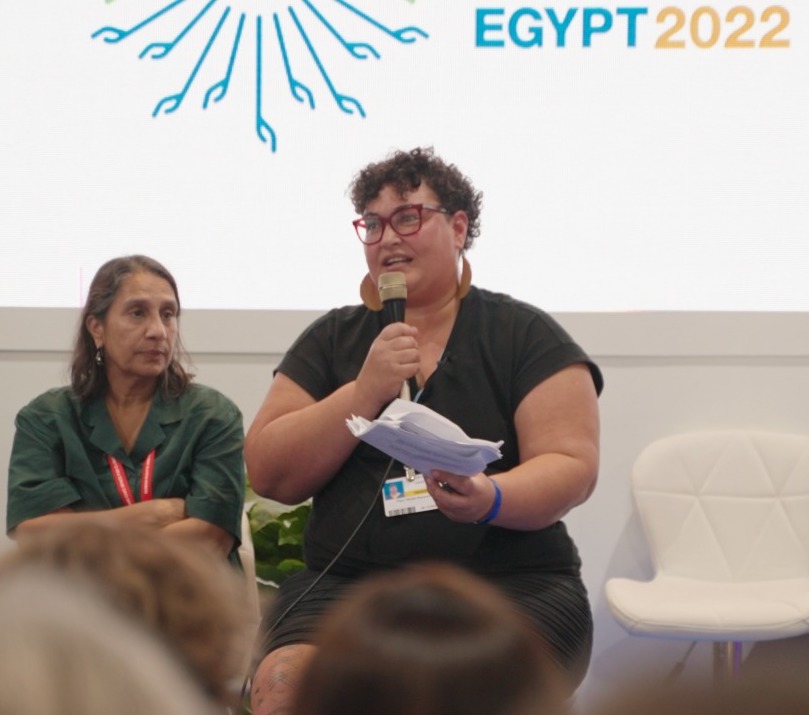
Fleur Ramsay is the Head of Litigation and Climate Lead for the Pasifika Program at EDO in Sydney.
The program partners with local organisations to protect the environment and the human rights of Indigenous peoples and local communities in the Pacific. The program also engages with international mechanisms and international law with the aim to ensure that states meet their legal obligations to the environment and to communities.
Fleur is an expert in indigenous rights and international environmental law and is an experienced litigator. She also has expertise in the intersection of human rights and environmental issues.
Fleur, what’s a day in the life as Litigation and Climate Lead of EDO’s Pasifika Program?
I don’t think I have a typical day in the life I can talk about. Our practice is one of the most dynamic at EDO. Our practice is also extremely diverse. We support work in many different places in the Pacific. In the last month I have been at COP 27 in Egypt, speaking at the Australian Attorney General’s International Law Colloquium in Canberra and at a climate justice gathering of First Nations, Pasifika and POC leaders in Australia (the first of its kind).
The legal work I do in one day will switch from working with the Program’s lawyers on what the scope of the right to a healthy environment is for cases we are running; work on submissions to the United Nations or OECD about various human rights violations around extractive industries; provide advice on free, prior and informed consent or draft court documents for a logging case in a specific jurisdiction.
I work with an incredible team of lawyers, who I wish to acknowledge here – Freda Talao our Managing Lawyer, Dr Bal Kama our Special Counsel, Watna Mori and Rohan Nanthakumar our Senior Solicitors and Lee Strangio our Program and Legal Administrator.
Why does the Pasifika Program exist? What are some of the big goals you’re working towards?
EDO is a regional organisation and we have recognised Australia’s place and role in the Pacific. In line with best practice with working with indigenous peoples, EDO has a Pasifika-led Pasifika Program which includes diaspora Pasifika lawyers (I am Samoan, for example) who have cultural and spiritual links to the Pacific and bring an innovative and sophisticated approach to working there.
We predominately work with partner organisations in the region and our geographical reach includes Vanuatu, Fiji, Solomon Islands, Papua New Guinea, Tuvalu. The Pacific has many environmental issues, including destructive extractive industries and is at the forefront of the brunt of the climate crisis and we provide critical support to our partner organisations.
We are currently working on loss and damage and how to value loss and damage and to put a true monetary value on the cultural labour that Pasifika peoples have undertaken for millennia to keep their environments sustainable and an inheritance for present and future generations, which have been undermined by fossil fuel emissions emanating elsewhere.
What motivates you to do this work?
I can’t not do this work. I feel emotionally invested in the Pacific region and have strong ancestral links to Samoa.
We are unique – covering a 1/3 of the globe with 1/3 of the languages and those languages are tied to place (seas, waters and land). We also have a lot of the world’s biodiversity. For example, Papua New Guinea has the third largest rainforest in the world, which is sadly not well known in Australia. We are also predominately subsistence peoples and are custodians of our lands, seas and waters.
Our precious places are at risk from climate change, and it breaks my heart that our human right to survive (which is no more than 1.5C temperature rise) is treated as if it is “up for negotiation” by the rest of the world. I believe this is climate racism, where we are seen as small and expendable and that our human rights are to be sacrificed.
As the Pacific Climate Warriors say: “we are fighting, not drowning” and I am using my privileged legal education (something that Pacific peoples cannot access easily) to support that fight in the climate space as well as against all extractive processes which threaten our precious Pasifika cultures and vital spaces.
What’s unique from a legal perspective about running climate litigation in the Pacific?
So much! I feel like I could write a whole paper on the challenges of environmental lawyering in the Pacific and the innovative work we are doing there.
But here are some headline differences. Unlike Australia, customary law and governance (the way that local communities organise themselves and their lands and maritime territories) is recognised as law in many of the jurisdictions that we work in.
Moreover, land tenue of the communities is protected in constitutions. We also have enforceable human rights in Pacific constitutions. So, the legal systems are legally pluralistic. How customary law does and should interact with the State legal systems is complex but also provides an opportunity for the development of unique environmental laws that are driven by communities (rather than a technical top-down exercise).
However, bringing cases are logistically challenging – communities live remotely and there are security challenges in some of the places where we work (including, from police and private security who are paid by developers). Moreover, we are often dealing with many landowners (land is communally held) and identifying the plaintiffs can be a challenge.
Our partners in Papua New Guinea are heroic because they must trek long hours, spend days in boats, etc to get into communities to provide the legal support that they need.
Can you tell us about an interesting or ground-breaking case that you’ve worked on?
We have been working with PNG-based Centre for Environmental Law and Community Rights, Jubilee Australia and Project Sepik on saving the Sepik River from a proposed tailings dam on a tributary of the Sepik River associated with a gold and copper mine (see, https://savethesepik.org/).
The dam will be massive (approximately 2.5 times the size of Sydney harbour) and is in a seismically active area. There are real concerns about that dam breaking, which will cause catastrophic loss of life and destroy a pristine and beautiful River which is of such profound spiritual significance to the many communities that live along the River. We have been working with the communities on customary law statements about the significance of the River to those communities and the cultural rights of that River.
This work is inspired by rights of nature models which have been developed by indigenous peoples, but will be deeply embedded in the cosmovision of the locals who call the Sepik River their home and the Mother of all life.
You were invited to be on a panel at the recently COP27. What was it like to be there, personally and professionally?
I was invited to attend COP27 by the Fossil Fuel Non-Proliferation Treaty Initiative (FFNPT) and I will be leading work to provide legal support to the FFNPT.
The FFNPT has three pillars:
(1) no new fossil fuel projects
(2) an equitable phasing out of new fossil fuel projects in line with 1.5C
(3) and a just transition where no person or community is left behind.
The FFNPT is to complement the Paris Agreement by requiring a tackling of the problem at its source (i.e., fossil fuels). Both Vanuatu and Tuvalu have endorsed the treaty.
I spoke on three panels at COP 27, including one on Just Transitions, one on free, prior and informed consent and the FFNPT and a Talanoa (dialogue/discussion) on Pacific Treaty Champions at COP 27.
It was great to get to speak at COP 27. I am one of very few Pasifika lawyers who has climate change law expertise.
On a personal level, I met so many amazing people from the Pacific and other indigenous peoples and this was the highlight for me. I am so impressed with the solutions that Pasifika and indigenous climate activists have come up with to our global ecological crisis, but we are often not platformed to be able to share these solutions.
What do you think the outcomes of COP27 were for Pasifika peoples?
The creation of a loss and damage fund was historic, which Pasifika Island States have been advocating for because their contributions to the climate crisis are negligible but are on its frontlines.
The problem is that there has been no agreement around who should pay or is responsible for loss and damage – it is one thing to have a fund; another thing to have money in it. Pasifika leaders have been the leaders in the climate space, and it is only through their leadership that we have 1.5C as a limit to global warming.
There is recent scientific evidence that our earth systems (important ecological systems, such as reefs, artic ice sheet, Amazon rain forest, etc) might tip at 1.5C and accelerate our ecological/climate crisis.
While 1.5C should be seen as a hard limit for us all and is essential to Pacific survival, there were very troubling pushes at COP 27 to not adhere to the 1.5C limit. Plus, many countries included delegates from fossil fuel countries, which combined outnumbered the delegates from Pacific countries.





